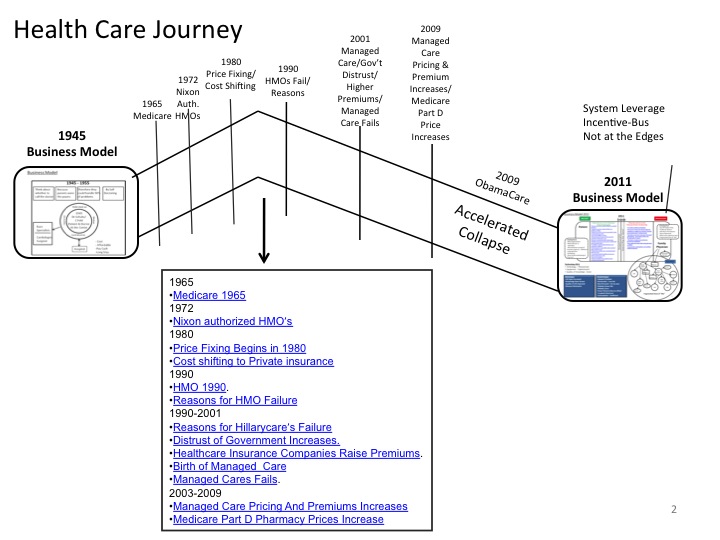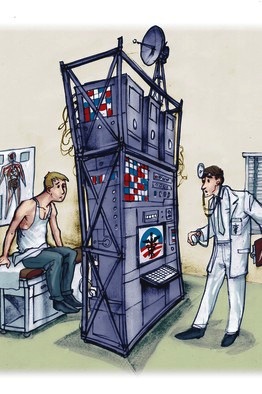Incentives and Mechanism Design
Stanley Feld M.D.,FACP,MACE
Why are Obamacare’s initiatives failing? There are several reasons.
1. Government is inefficient. It outsources all of its administrative services.
The contractors, in turn, subcontract out most of the work. The overhead for each function increases non-transparent costs. The execution of tasks decreases.
2. President Obama’s healthcare policy advisors are academics. They have little clinical experience. It is clear they have little experience in the trenches.
The healthcare policy advisors have no idea how to create incentives for physicians and hospitals.
They have no idea how destructive to clinical practice the lack of tort reform is.
3. Without clinical experience the policy advisors do not know how to create effective incentives for patients.
I have emphasized that patients must be responsible for themselves and their diseases. They must become professors of their diseases. They have to be provided with adequate incentives to become professors of their diseases.
Physicians must be provided with incentives to teach patients to be professors of their diseases.
4. The government outsources the administrative services to adjudicated Medicare and Obamacare billings. The government has little idea of the actual profits built into the fees the insurance companies charge the government. At intervals insurance companies are required to enter another bidding process. The government probably picks the lowest bidder.
It is not an efficient way to pick an insurance company. This is especially true when the government guarantees the insurance company‘s profit. The government does not know what the insurance company’s profit actually is. The profit is about 40% of the healthcare dollars.
President Obama’s ideological goal leads to these errors. His only concern is for the government to control the healthcare system.
Government control of a healthcare system has not been successful. The V.A. healthcare system is on example. Medicaid and Medicare’s increasing deficits has been another example.
A few years ago I learned about “Mechanism Design.” My first reaction was “what is that?”
Mechanism Design is a brilliant economic theory. If the theory was applied to the healthcare system it could solve much the system’s dysfunction.
When I wrote about Mechanism Design I felt that few people understood it.
What is it? Mechanism Design is the art and science of designing rules of a game to achieve a specific outcome, even though each participant may have a separate vested self-interest.
The design of the game is to align all the stakeholders’ vested self-interests.
Each stakeholder has an incentive to behave as the game designer intends. The game can then implement the desired outcome.
The strength of such a result depends on the solution concept used in the game.
None of the stakeholders’ vested interests are aligned in Obamacare except the vested self-interest of President Obama and his ideology.
The healthcare insurance industry thinks it has President Obama over a barrel.
Some of the hospital systems have figured out that they will be at the mercy of Obamacare.
Physicians already feel they are at the mercy of President Obama’s ideology.
Medical device companies and pharmaceutical companies have figured out they are dead already. It is only a matter of time until they cannot move. They are working around the system to come back from the dead.
None of the stakeholder’s vested interests are are aligned. This non-alignment will lead to destruction of the healthcare system.
Mechanism designers commonly try to achieve the following basic outcomes for stakeholders: truthfulness, individual rationality, budget balance, and social welfare.
With those four outcomes for stakeholders in the healthcare system one could get close to aligning stakeholders incentives.
Lodi Hurwicz’ point is the way to get as close to the most efficient economic outcomes is to design mechanisms in which everyone does best for themselves.
He says this can be achieved by sharing information truthfully (Price Transparency). It is easy to understand that some people can do better than others by not sharing information or lying in the short term. It will not serve all the stakeholders’ vested self-interest in the long term.
If everyone’s incentives are aligned you have a much more efficient economic system.
The example given in the military is defense contracting. If you agree to pay on a cost plus basis you have created incentives for the contractor to be inefficient.
If you do not you have incentives aligned and truthful information you create the incentive to be overcharged. Most people can do better by not sharing truthful information.
Many have observed that Obamacare has not been transparent or truthful.
If the rules of the game require truthful information you can get close to an efficient market driven solution.
The concept of Pareto efficiency means no one can be made better off without someone becoming worse off.
Hurwicz observed, as had others, that the dispersion of information was at the heart of the failure of a planned economy.
He observed that the free market economy can get us closer than central planning to incentive compatibility because in the end the consumer can drive the discovery of truthful information
A free market economy is by no means immune to the Pareto efficiency concept.
However, the free market mechanism was far less afflicted than central planning bureaucracy. A consumer driven system serves to force truthfulness.
Empowering consumers is the key to an efficient system. Customers determine success of an enterprise by creating demand. In a transparent environment they can get closer to incentive efficiency. They create the rules of the game for compatible incentive.
How does Mechanism Design relate to the Repairing The Healthcare System?
The rules of the games can align all the stakeholders’ incentives without one stakeholder taking advantage of another.
In our healthcare system everyone is pursuing his vested interest in a game that has rules that do not lead to “incentive compatibility.”
Some politicians think central planning will straighten out the rules. Historically, central planning has not worked. These Nobel Prize winners in economics have proven this fact.
A consumer driven healthcare system using the ideal medical saving account. Will be a good start in achieving alignment of all the stakeholders.
The opinions expressed in the blog “Repairing The Healthcare System” are, mine and mine alone
Please have a friend subscribe

